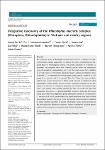




The taxonomic status of Rhinolophus macrotis sensu lato (s.l.) in Vietnam and adjacent territories remains problematic. To address this issue, we performed an integrated study of morphological, acoustic, and genetic characters of R. macrotis s.l. specimens and compared these with sympatric species within the philippinensis group (R. marshalli, R. paradoxolophus, and R. rex). Our results reveal that in addition to a cryptic species of R. macrotis previously found in Jiangxi and Jingmen, China, R. macrotis s.l. in continental Asia includes three further species, namely R. cf. siamensis, R. cf. macrotis, and R. cf. macrotis “Phia Oac.” These four taxa are distinguished from genuine R. macrotis in Nepal and R. siamensis in Thailand by their morphological and/or genetic features. Further taxonomic evaluation of the subspecies of R. macrotis s.l. is needed to determine their affinities with recently recognized cryptic species and to possibly describe new taxa. Our results also show that interspecific divergences in mitochondrial DNA sequences (Cytb and COI genes) among taxa within the philippinensis group (particularly between R. cf. siamensis/R. cf. macrotis and R. rex/R. paradoxolophus) are significantly lower than those of other morphological groups in the genus. These phylogenetic patterns might be explained by recent allopatric speciation or ancient introgression events among ancestors of the taxa during the Pleistocene. However, further investigations including genetic analyses of nuclear genes are needed to test the latter hypothesis.
Readership Map
Content Distribution


The taxonomic status of Rhinolophus macrotis sensu lato (s.l.) in Vietnam and adjacent territories remains problematic. To address this issue, we performed an integrated study of morphological, acoustic, and genetic characters of R. macrotis s.l. specimens and compared these with sympatric species within the philippinensis group (R. marshalli, R. paradoxolophus, and R. rex). Our results reveal that in addition to a cryptic species of R. macrotis previously found in Jiangxi and Jingmen, China, R. macrotis s.l. in continental Asia includes three further species, namely R. cf. siamensis, R. cf. macrotis, and R. cf. macrotis “Phia Oac.” These four taxa are distinguished from genuine R. macrotis in Nepal and R. siamensis in Thailand by their morphological and/or genetic features. Further taxonomic evaluation of the subspecies of R. macrotis s.l. is needed to determine their affinities with recently recognized cryptic species and to possibly describe new taxa. Our results also show that interspecific divergences in mitochondrial DNA sequences (Cytb and COI genes) among taxa within the philippinensis group (particularly between R. cf. siamensis/R. cf. macrotis and R. rex/R. paradoxolophus) are significantly lower than those of other morphological groups in the genus. These phylogenetic patterns might be explained by recent allopatric speciation or ancient introgression events among ancestors of the taxa during the Pleistocene. However, further investigations including genetic analyses of nuclear genes are needed to test the latter hypothesis.